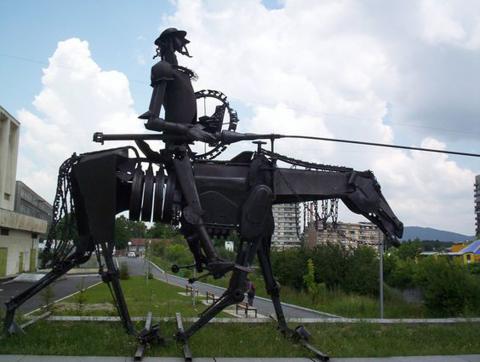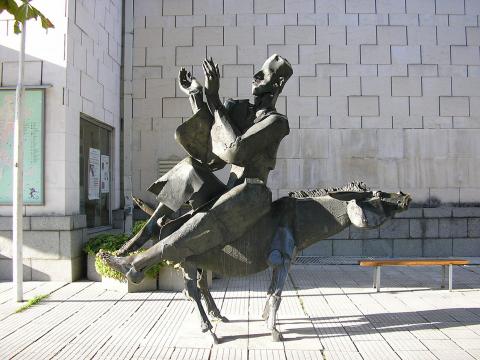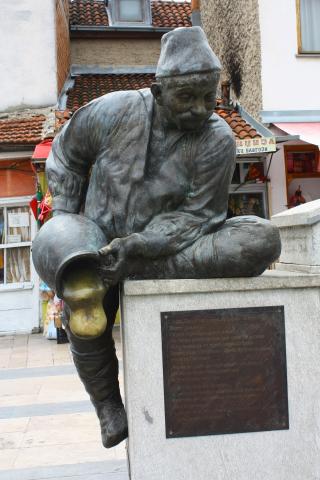
No siendo conocida por el especial humor de su gente, debido a la influencia otomana, conoció las ironías humorísticas de Nasreddin Hoca, además de compartir con los macedonios el ingenioso Hitar Petar. Pero hoy quise centrarme en las montañas centrales del país donde existe una ciudad totalmente dedicada al humorismo, local e internacional, con museos y exposiciones sobre todos los géneros humorísticos: Gabrovo.
Este centro humorístico nació en 1972, en un gesto de irreverencia y astucia económica, dentro de un país, de un sistema comunista (Telón de Acero), poco receptivo a la libertad de la irreverencia humorística, imponiendo de inmediato su lema: «¡El mundo dura, porque te ríes!».
La gente de allí es el blanco del humor del país, sobre todo por su avaricia (a los gatos les cortan la cola para ahorrar energía cuando entran y salen de casa), por la astucia de los comerciantes (vieron un agujero en este nicho de mercado de la historieta cuando nadie lo explotaba), a través de subterfugios experienciales (en lugar de pedir autorización para crear un museo, adaptaron un antiguo almacén para albergar exposiciones, adaptación que no requería autorización del gobierno central). Así nació la Casa del Humor y la Sátira, que organiza desde entonces la Bienal Internacional del Humor y la Sátira en las Artes (IBHSA) / El encuentro nacional de narradores de anécdotas de Blagolazh / Carnaval del humor y la sátira / Exposiciones temporales de artistas de todo el mundo. Su emblema es el globo terrestre con ojos y orejas de gato, para "ver y oír" el estado de ánimo del mundo.
Para conocer mejor este «monumento del humor mundial», cedemos la palabra a su actual directora Margarita Dorovska: «Antes de la caída del Muro de Berlín, este lugar era conocido como la capital comunista del humor, extendiendo su alcance a los países del Bloque del Este y también a ciertos círculos del Oeste. Todo esto comenzó cuando el municipio relevó las anécdotas que existían sobre y alrededor de Gabrovo y lo publicó en un libro, que fue un gran éxito. Vincular esto a la recuperación del tradicional Carnaval de Gabrovo en los años 60 (que se sabía que tenía mucho humor político y sátira) hizo germinar la idea de explorar todos los aspectos del humor en una dinámica cultural más profunda. Utilizando los chistes de Gabrovo como «Horse de Tróia» para presentar una sátira más política, que es lo que llevó a algunos gabrovianos emprendedores a abrir un museo.
Inmediatamente empezaron con las bienales, la primera edición de las bienales estuvo dedicada a dibujos de humor y pequeñas esculturas satíricas. Fue internacional y trajeron nombres increíbles. ¿Cómo puede existir esto? Si piensas en aquel entonces, la mayoría de los caricaturistas del mundo occidental serían críticos, de izquierda. Por lo tanto, serían muy bienvenidos en Bulgaria. Y esto sí que sería un punto de encuentro entre Oriente y Occidente».
Con la caída del comunismo, ¿cómo logró sobrevivir el Museo? «En 1989, llegaron a la bienal más de 80 invitados extranjeros, artistas, jurados. Después de 1989, se produjo el colapso de facto. En ese momento había más de 100 personas trabajando en Casa do Humor. Porque si piensas en todos los departamentos: cine, literatura, folklore, fue una empresa enorme, con muchos eventos, con exhibiciones increíbles. Hoy somos una docena...».
A pesar de todo, con su 25 Bienal se inician cincuenta años de subsistencia bajo el comunismo, reinventándose en democracia y en nuevas tecnologías que saltan la forma de comunicar humor.
Mundo del Humor - Museos del Humor
Esa mueca efímera de los labios, ese breve sonido explosivo de placer, ese destello filosófico de ver la cotidianidad con ojos para ver, ¿pueden encerrarse en museos? Las entidades gubernamentales, la cultura oficial, temerosas de cualquier irreverencia, prefieren decir que no, por eso hay tan pocos museos del humor en el mundo subvencionados por el poder central. La mayoría que existen fueron creadas y son mantenidas por particulares o por asociaciones de artistas, por fundaciones.
Pero, ¿qué debe ser un Museo del Humor? ¿Un depósito de obras, en una concepción de la evolución estética de este arte, o debe ser un Museo de carácter sociológico y psicológico, como Museo de la Historia de un país, de un continente en una visión irreverente e innovadora? La creación de un Museo del Humor es difícil, y no puede ser tan lineal como la creación de cualquier otro Museo. Sus características intrínsecas de este género, requiere una dinámica diferente, por lo que prefiero la designación de Casa do Humor, en lugar de Museo. ¿Debe ser un lugar de exposiciones o de actividades pedagógicas, de introspección política y social? Una casa como esta debe ser un centro de investigación, debe realizar un trabajo sociológico y terapéutico con constante intervencionismo social. ¿Debería abarcar la interdisciplinariedad o restringirse a un campo específico, como la gráfica????
En la práctica, lo que encontramos son Museos que nacieron para albergar colecciones privadas (Casas-Museo de artistas como en Portugal – Leal da Câmara y Raphael Bordallo Pinheiro; Dinamarca - Storm, Rumanía – Popas…) que se oficializaron, o como complemento la actividad de Festivales. En total, no llegarán a las cuatro decenas: 21 en Europa (España, Francia, Reino Unido, Bélgica, Países Bajos, Suecia, Alemania (3), Polonia, Suiza, Austria, Luxemburgo, Italia, Serbia, Bulgaria, Rusia y Turquía). En las Américas ha habido Museos, que a veces desaparecen, por falta de medios de subsistencia, reaparecen después... concretamente en Brasil, Uruguay, Argentina, Cuba, México, USA y Canadá. En Oriente Medio y Asia, Irán había dos Casas del Humor / Museos, Egipto así como Israel, Azerbaiyán, Indonesia, Japón…
En este contexto, el museo más famoso es precisamente el llamado Casa del Humor y la Sátira en Gabrovo, Bulgaria (humourhouse.org). Creada en 1972, con su Bienal Internacional de Humor y Sátira en las Artes, que abarca historieta, dibujo humorístico, pintura, diseño gráfico, escultura y fotografía. Es considerado el Museo más grande del mundo, con más de 50.000 originales, y una Biblioteca con más de 25.000 títulos en 35 idiomas.
Por los datos que tengo, el primero que se crea data de 1951, y es el Museu de la Caricatura Severo Vaccaro Lima, con sede en Buenos Aires. Habiendo comenzado como una galería de arte a principios del siglo XX, con la muerte de su tutor, el hijo, Vicente Vaccaro crea una Fundación y en consecuencia un Museo. Luego de varias vicisitudes, y de un casi estancamiento en la década del 90, en 2003, bajo la batuta de Marcelo Niño y Francisco Mazza, busca recuperar su rol como polo dinamizador del humor argentino.
Ya que en Argentina hablamos de sumar otras formas originales de hacer Museos, es decir, itinerantes. Uno de ellos, organizado por el propio Marcelo Niño, se denomina Museo Itinerante de los Humoristas Gráficos e Ilustradores Argentinos, aunque busca tener una sede física en Lomas de Zamora. El otro, creado en la Ciudad de Salta, se denomina Museo del Humor Gráfico, el Cuento y la Caricatura de "Salta la Risa", dirigido por Gustavo Flores.
El primer Museo Europeo data de 1970, y está ubicado en Italia. Es el Museo Internazionale della Caricature e dell'Umorismo de Tolentino. Aparecerá en sustitución de la Bienal Internazionalle dell'Umor, creada en 1961 por Luigi Mari. Este mecenas e investigador reunió obras que van desde el siglo XVII hasta el siglo XIX. XVIII a la actualidad a nivel mundial, reuniendo más de 3.000 originales.
Curiosamente, casi el 50% de los Museos nacieron en la década de 1970. Sin duda fruto de la conciencia política de la sociedad que vivía en esos años, con una fuerte irreverencia política. Fue en este momento cuando el arte del humor gráfico dejó de ser un boceto para imprimir y pasó a ser una obra de arte, un documento iconográfico de su tiempo. Comenzaron entonces las principales colecciones, archivos gráficos de humor, intentando aún recuperar el pasado, asegurando el futuro.
En Inglaterra también existe una Universidad, la de Kent-Canterbury, con el Centro para el Estudio de la Historieta (creado en 1973), que lidera la investigación, recopilación y conservación de obras. El Cartoon Art Trust, con sede en Londres, busca ser el eventual Museo en diálogo con ese Centro de Investigación.
En Irán, el Norte y el Sur compiten como centros del humor, con sus Museos y con sus actividades en Salones y exposiciones temporales en Teherán y Tabriz (creo que entretanto Tabriz cerro). En Nueva Zelanda, la Biblioteca Nacional tiene un departamento especial llamado Cartoon Archive. En Japón hay al menos un Museo en Hokkaido y otro en Omya-Saitana.
En Canadá tenemos noticias del Museo Canadiense de la Caricatura en Ottawa, vinculado a los Archivos Nacionales (archives.ca), y en Montreal el Museo Just pour Rire, una organización muy interesante, ya que trabaja, además de los clásicos apoyo de dibujo, multimedia, espectáculos, cabaret, música, talleres y talleres infantiles.
Finalmente, en USA hay un intento interesante de crear espacios museísticos, proyectos de colecciones muy interesantes, con buenas colecciones, pero que tienen dificultades para conseguir sedes fijas y apoyo económico. La más nacional será la Colección Swain, creada en la década de 1960 y depositada en la Biblioteca del Congreso en 1974, que engloba caricaturas estadounidenses desde 1780 hasta la actualidad.




Humors of the World – Bulgaria / Gabrovo
By: Osvaldo Macedo de Sousa
Not being known for the special humor of its people, due to the Ottoman influence it got to know the humorous ironies of Nasreddin Hoca, as well as sharing with the Macedonians the witty Hitar Petar but today I wanted to focus on the central mountains of the country where there is a city totally dedicated to the humorism, local and international, with museums and exhibitions on all humorous genres: Gabrovo.
This humorous center was born in 1972, in a gesture of irreverence and economic cleverness, within a country, of a communist system (Iron Curtain) that was not very receptive to the freedom of humorous irreverence, immediately imposing its motto - «The world lasts, because you laugh!”. The people there are the target of the country's humour, mainly because of their avarice (they cut the cats' tails to save energy when they come in and out of the house), because of the cleverness of traders (they saw a hole in this comic market niche when no one was exploiting it) , through experiential subterfuges (instead of asking for authorization to create a museum, they adapted an old warehouse to hold exhibitions, an adaptation that did not require authorization from the central government)… thus was born the House of Humor and Satire, which it organizes since then. the International Biennale of Humor and Satire in the Arts (IBHSA) / The Blagolazh national gathering of anecdote-tellers / Carnival of humor and satire / Temporary exhibitions by artists from around the world. Its emblem is the terrestrial globe with the eyes and ears of a cat, to "see and hear" the humor of the world.
To get to know this «monument of world humor better», we give the floor to its current director Margarita Dorovska: « Before the fall of the Berlin Wall, this place was known as the communist capital of humor, extending its reach to the countries of the Eastern Bloc and also to certain circles in the West. This all started when the municipality surveyed the anecdotes that existed about and around Gabrovo and published it in a book, which was a great success. Linking this to the recovery of the traditional Carnival of Gabrovo in the 60's (which was known to have a lot of political humor and satire germinated the idea of exploring all aspects of humor in a deeper cultural dynamic. Using Gabrovo's jokes as a «Horse de Tróia» to present a more political satire, which is what led some enterprising Gabrovians to open a museum.
They immediately started with the biennials, the first edition of the biennials was dedicated to cartoons and small satirical sculptures. It was international and they brought incredible names. How can this exist? If you think back then, most cartoonists in the western world would be critical, left wing. Therefore, they would be very welcome in Bulgaria. And this would indeed be a meeting point for East and West».
With the fall of communism, how did the Museum manage to survive? «In 1989, they had more than 80 foreign guests, artists, juries coming to the biennale. After 1989, there was the de facto collapse. At that time there were more than 100 people working at Casa do Humor. Because if you think about all departments: cinema, literature, folklore, it was a huge undertaking, with many events, with incredible exhibitions. Today we are a dozen...».
In spite of everything, with its 25th Bienal, fifty years of subsistence began under communism, reinventing itself in democracy and in new technologies that leapfrog the way of communicating moods.
World of Humor - Museums of Humor
By: Osvaldo Macedo de Sousa
Can that ephemeral grimace of the lips, that brief explosive sound of pleasure, that philosophical flash of seeing everyday life with eyes to see, be enclosed in museums? Government entities, the official culture, fearful of any irreverence, prefer to say no, which is why there are so few museums of humor in the world subsidized by the central power. The majority that exist were created and are maintained by private individuals or by associations of artists, by foundations.
But what should a Museum of Humor be? A deposit of works, in a conception of the aesthetic evolution of this art, or should it be a Museum of a sociological and psychological nature, as a Museum of the History of a country, of a continent in an irreverent and innovative vision? The creation of a Museum of Humor is difficult, and it cannot be as linear as the creation of any other Museum. Its intrinsic characteristics of this genre, requires a different dynamic, which is why I prefer the designation of Casa do Humor, instead of Museum. Should it be a place for exhibitions or pedagogical activities, for political and social introspection? A house like this should be a research center, it should carry out sociological and therapeutic work with constant social interventionism. Should it encompass interdisciplinarity, or be restricted to a specific field, such as graphics????
In practice, what we find are Museums that were born to house private collections (House-Museums of artists such as in Portugal – Leal da Câmara and Raphael Bordallo Pinheiro; Denmark- Storm, Romania – Popas…) that became official, or as complement the activity of Festivals. In total, they will not reach four dozen: 21 in Europe (Spain, France, United Kingdom, Belgium, Netherlands, Sweden, Germany (3), Poland, Switzerland, Austria, Luxembourg, Italy, Serbia, Bulgaria, Russia and Turkey. In the Americas there have been Museums, which sometimes disappear, due to lack of means of subsistence, reappearing later... namely in Brazil, Uruguay, Argentina, Cuba, Mexico, USA and Canada.In the Middle East and Asia, Iran has two Houses of Humor / Museums, Egypt as well as Israel, Azerbaijan, Indonesia, Japan…
In this context, the most famous museum is precisely the one called the House of Humor and Satyre in Gabrovo, Bulgaria (www.humourhouse.org). Created in 1972, with its International Biennial of Humor and Satire in the Arts, encompassing cartoon, humor drawing, painting, graphic design, sculpture and photography. It is considered the largest Museum in the world, having more than 50,000 originals, and a Library with more than 25,000 titles in 35 languages.
From the data I have, the first to be created dates back to 1951, and it is the Museu de la Caricatura Severo Vaccaro Lima, based in Buenos Aires. Having started as an Art Gallery at the beginning of the sec. XX, with the death of his guardian, the son, Vicente Vaccaro creates a Foundation and consequently a Museum. After several vicissitudes, and a near standstill in the 90s, in 2003, under the baton of Marcelo Niño and Francisco Mazza, it seeks to recover its role as a dynamic pole of Argentine humor.
Since we talk in Argentina about adding other original ways of creating Museums, that is - itinerant ones. One of them, organized by Marcelo Niño himself, is called the Itinerant Museum of Graphic Humorists and Argentinian Illustrators, although it seeks to have a physical base in Lomas de Zamora. The other, created in the City of Salta, is called the Museum of Graphic Humor, Short Stories and Caricatures of "Salta la Risa", directed by Gustavo Flores.
The first European Museum dates from 1970, and is located in Italy. It is the Museo Internazionale della Caricature e dell'Umorismo de Tolentino. It will appear as a substitute for the Bienal Internazionalle dell'Umor, created in 1961 by Luigi Mari. This Maecenas and researcher gathered works ranging from the 17th century to the 19th century. XVIII to the present worldwide, bringing together more than 3,000 originals.
Interestingly, almost 50% of Museums were born in the 1970s. Certainly the result of the political awareness of society that lived in those years, with a strong political irreverence. It was at this time that the art of graphic humor ceased to be a sketch to be printed, and became a work of art, an iconographic document of its time. Then began the main collections, graphic archives of humor, still trying to recover the past, ensuring the future.
In England there is also a University, that of Kent-Canterbury, with the Center for the Study of Cartoon (created in 1973), which leads the research, collection and conservation of works. The Cartoon Art Trust, based in London, seeks to be the eventual Museum in dialogue with that Research Centre.
In Iran, the North and the South compete as centers of humor, with their Museums and with their activities in Salons and temporary exhibitions in Tehran and Tabriz. In New Zealand, the National Library has a special department called the Cartoon Archive. In Japan there is at least one Museum in Hokkaido and another in Omya-Saitana.
In Canada we have news from the Canadian Museum of Caricature in Ottawa, linked to the National Archives (www.archives.ca), and in Montreal the Just pour Rire Museum, a very interesting organization, as it works, in addition to the classic support of drawing, multimedia, shows, cabaret, music, workshops and children's workshops.
Finally, in the USA, there is an interesting attempt to create museum spaces, projects for very interesting collections, with good collections, but which find it difficult to obtain fixed headquarters and economic support. The most national will be the Swain Collection, created in the 1960s and deposited at the Library of Congress in 1974, which encompasses American cartoons from 1780 to the present day.
